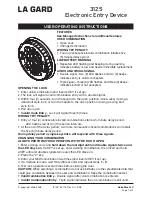
North American Clutch & Driveline
Rockford, Illinois
Phone: (800) 383-9204
(815) 282-7960
Fax (815) 282-9160
www.naclutch.com
39
39
ClUTCH eNgAgeMeNT PROCeDURe
Normal Clutch engagement
An NACD PTO clutch should normally be engaged with the engine at the lowest RPM
possible. The clutch should be engaged quickly to avoid an extended period of slippage during
engagement. The clutch should be engaged with the engine operating below 1,000 RPM .
After the clutch is fully engaged and the load has been brought up to engine engagement
speed, the engine RPM may be increased to operating speed.
Clutch engagement Where High Inertia loads exist
NACD recommends that the PTO installation be designed to allow clutch engagement at 1,000
RPM or below. Under extreme circumstances, where high inertia loads must be picked up, the
engine may have to be operated at higher speeds while the engagement occurs, as engaging
the clutch at 1,000 RPM or below may result in stalling the engine.
Clutch engagement should occur at the lowest possible engine RPM .
Heavy inertia loads may be brought up to engine speed by a series of short clutch engagements
and disengagements at intervals long enough to gradually increase the speed of the load, yet
prevent excessive heat buildup in the friction facings.
After the clutch is fully engaged and the load has been brought up to engine engagement
speed, the engine RPM may be increased to operating speed.
Under no circumstances should the clutch be slipped for more than a second or two without
either fully engaging or disengaging the clutch to permit it to cool.
















































